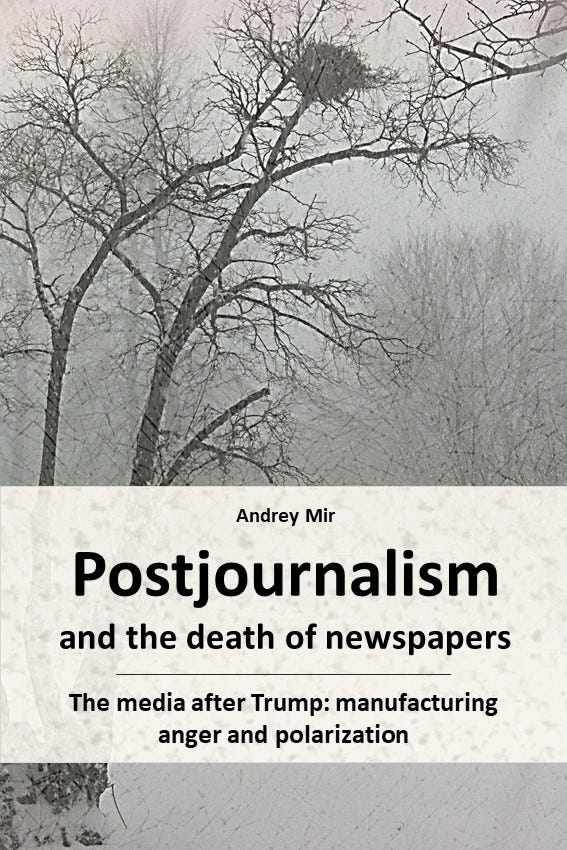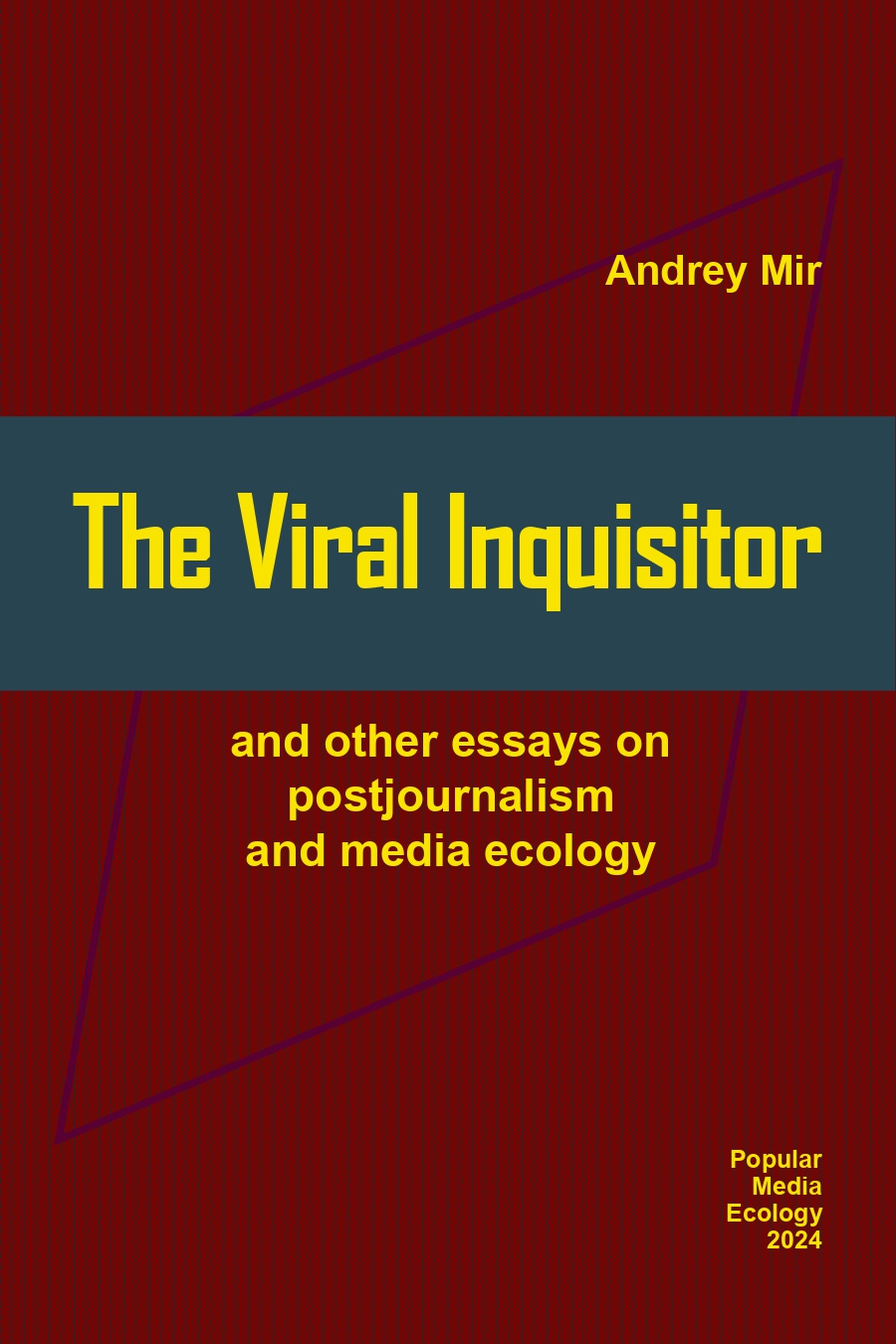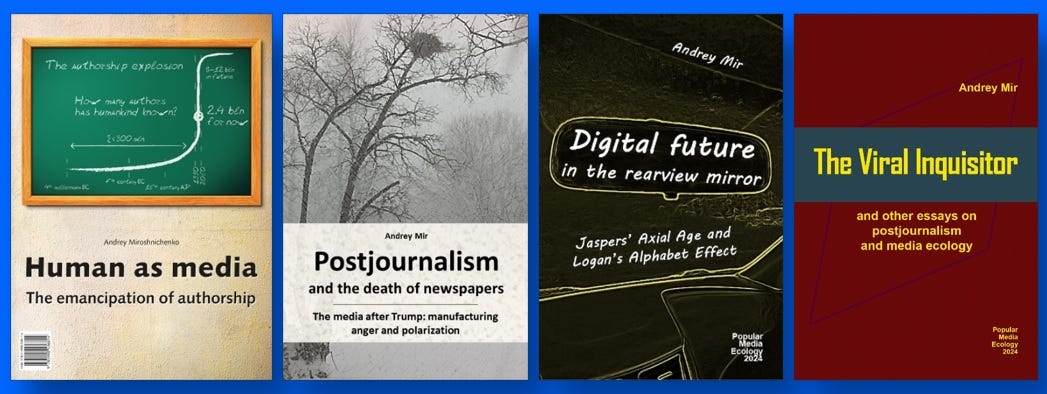Post-truth: too good to be true
Journalism wants its picture to match the world. Postjournalism wants the world to match its picture.
(A chapter from 2020 Postjournalism and the death of newspapers. The media after Trump: manufacturing anger and polarization.)
The world seen through the prism of the media was always distorted. However, under each mode of production, there were professional standards that declared the value of objective truth and were able to mitigate (or hide) the distortions to some extent.
News retail, meaning the selling of news downwards, to the audience, had always employed the best fact-checker – the market demand. If readers wanted guidance for their social and business activity and safety, they buy news that is real. They would stop buying errors and fakes (unless they wanted fakes). The media based on news retail sought to grasp the world-as-it-is. At the systemic level, the invisible hand of market-driven fact-checking could be distorted only by negativity bias (the attraction of readers to terrifying news) or by the malpractice of journalists.
Audience wholesaling, the selling of agenda upwards, to advertisers or political sponsors, required a significant doctoring of the world picture. The focus on sponsored topics, avoiding unwanted issues and manufacturing consent were the systemic features. However, the success of this model depended on circulation and audience outreach. Since the media were paid for gathering the audience by content, they could not afford to repel the audience through unduly false news. The adequacy and relevance of the picture of the world was still a business factor.
***
The picture of the world-as-it-is relies on truth. Truth can be distorted or manipulated, but the demand for the news assumes that truth is at the core, and this truth is potentially verified by evidence, authority, knowledge, expertise, regularities and other ways to align as closely as possible with the truth. Truth is needed as a form of guidance that matches the objective reality. Individuals, communities and society need it for successful or secure functioning. Truth must match reality, not ideology; ideology oftentimes intervenes, but it is admitted as abuse and condemned.
In depicting the world, the truth might never be achieved in practice, but it is assumed as an ideal to be cherished and striven for. The critical thinking of what is objective truth and how much it is impacted by social (class, ideological, etc.) constructing is included and does not revoke the regulative power of truth.
The picture of the world-as-it-should-be always has post-truth built into it. Truth as a regulator is irrelevant, as it is replaced with justice (in the best-case scenario) or appropriateness. A reflected reality must match the intent, not the world. The picture of the world-as-it-should-be serves its creator, not its user.
This is an important hallmark of post-truth. The picture of the world that one wishes to receive, most likely refers to truth, even when deceiving or distorted. The picture of the world that is meant to be imposed on others more likely reflects post-truth. It reflects the preferences of its social engineer, not its user.
***
Today’s news consumers start their daily online routine most often with the social media newsfeed on their smartphones. By the time (and if at all) users come to look at news media websites, they generally know all the news relevant to them. If the news is important but not verified by the repetitions of multiple headlines in the newsfeed, it needs to be validated by the media. Value validation of what is already known is the only news job left for the media. When facts are already known but are worrisome, factual reporting is no longer needed, and it must turn into evaluative commenting.
Within this media environment, the audience generally wants the media to validate or invalidate what it already knows and to scare readers with what they are already scared by. The media must confirm that the scare is legitimate. This ‘attitudinal’ news-validation function of news media based on the donscription model is at the core of the definition of post-truth.
In the conditions of news redundancy, the need for attitude is much more pressing than the need for news. Attitude precedes meaning in the ‘use-value’ of news supply by the media. The supremacy of attitude over meaning is an interesting postmodernist phenomenon: post-truth, actually, is pre-truth. The picture of the world-as-it-should-be always appears before the world-as-it-should-be comes into existence because its existence is the dissemination of its picture. Post-truth is a ‘post-’phenomenon historically, but, semantically, it is a ‘pre-’phenomenon. The world-as-it-should-be firstly belongs to its creator-observer, with observation turning into creation.
This semantic reversal was noticed by Ruth Marcus from the Washington Post. In 2017, she suggested to forget about the “post-truth presidency,” because that of Trump was the “pre-truth presidency.” Trump made statements ahead of them being true, and then they became true, at least in the reality he created for them. “In this way, Trump serves as a human Heisenberg principle, changing a measurable phenomenon by observing it,” wrote Marcus.[1]
Besides the Heisenberg principle, the reflection’s precession of what is to be reflected is, of course, reminiscent of the Baudrillardian concept of simulacrum (Baudrillard, 2012 [1981]). Also worthy of noting is the fact that creation by vision or pronouncing is a common religious idea of cosmogony.
***
In fact, the role of the reader in shaping media agendas has grown very slowly over 500 years of journalism, rapidly accelerating in the last couple of decades.
The first newspapers were audience-agnostic. The inner structure of the audience, even its feedback, was indistinguishable and even insignificant for the first mass media (which were, in reality, the elite media).
The first sign that newspapers started acknowledging the existence of the audience appeared when party newspapers emerged (circa late 18th century). They were not “newspapers for all who can read”. Even though their audience specification originated from its owners, not readers, the characteristics of the audience, for the first time, began to matter.
The audience started being distinguishable for the media when thematically-focused newspapers appeared – for the bourgeois, workers, merchants, scientists, women, children, etc. The role of the audience increased even more when readers started writing letters to editors and editors started publishing them. The audience gained a voice. The genre of the interview appeared, which allowed even an ordinary passerby to become a co-author of the agenda.
What a shock it must have been for the guild when a reader filed a lawsuit against a newspaper for the first time. Punishment from the powerful was not unfamiliar to editors and publishers, but an ordinary reader had never been seen as legally equal to a newspaper before that.
***
When users become able not only to consume media but also to input content into media, they get active and they get connected. From this interactivity, the participatory intervention of the audience into the media started. It has ended up, thus far, in user-generated content. The people formerly known as the audience now set the agenda, and they do it not only in the news media, but also without the news media at all.
What has happened in a cultural sense is that the audience has turned from a passive object to an active subject of agenda-setting. The Universe – the Multiverse, to be precise – has become user-centric.
This is an important prerequisite of post-truth. Content becomes increasingly obliged to match not the world (whatever it is), but the user, with all their needs (tastes, opinions, fallacies, etc.). At the beginning of the evolution of the news media, indistinguishable readers were given the content of the first newspapers in complete ignorance of who the readers were. At the end of the evolution of the news media, content now revolves around the user, personally distinguishing them and their needs.
This evolutionary mechanism eventually facilitates bettering users’ self-actualization on social media. It has completed the cultural shift in people's attitudes towards truth. With the transfer of content-centering from the producer’s end to the consumer’s end, truth has become detached from reality and attached to the user. The objectivity of the literate era’s truth has flipped to the subjectivity of the digital era’s post-truth.
A prosumer becomes the master of the reality. This makes the reality multiple and originating from many sources; basically, from all users and their content activity. Truth was universal; post-truth is multiversal. As Martin Gurri noted, “We aim to impose our facts and annihilate theirs, a process closer to intellectual holy war than to critical thinking.”[3] Making facts one’s own property is not solely Trump’s prerogative. When Nancy Pelosi stated, “I reject your facts!” [4] she demonstrated, essentially, the same attitude. To be true means to be good enough for me and those like me. If it is good in our personal parts of the Multiverse, who cares if it is the truth or not in the Universe.
***
The physical world would verify truth by sensorial experience, the most reliable of which is death. One cannot cheat death (so far), so people need to respect physical ways of truth verification.
Post-truth is truth in the digital environment, where the physical risks of ‘wrong’ interactions do not exist. If the physical reality is made of objects, the digital reality is made of subjects – of others. The sensorial feedback of wrongdoing, the pain of hitting against objects, has turned into the pain of hitting against subjects, against others.
Instead of physical risks, social risks become absolutized. Digital is pure social. In the digital world, death is ostracism and cancellation. Cancel culture is a digital analog of a tribe’s death penalty, similar to execution by stoning, where legitimacy is maintained by the collectivity. The numbers matter. This new regulator of wrongdoing is replacing the old criteria of truth: instead of the complying with the laws of the physical Universe, one now needs to comply with the values of the social Multiverse – or the part of it to which a person wants or needs to belong.
In the physical reality, the concept of irrefutable truth, ultimately verified by death, ended up being written in the Book: the Torah, the Bhagavad-Gita, the Bible, the Quran and some others. The irrefutability of physical principles, naturally maintained by the sensorium and the fear of pain and death, evolved into the same unquestioned set of moral rules and then scientific laws. The irrefutability is what is (was) truth.
The idea of unified supreme knowledge, considered to be a source of truth and, later, also of hegemony and oppression, naturally dissolves as humans resettle into the digital environment.
There is no highest universal truth anchored in irrefutable laws anymore. In the participatory environment, the sole center of absolute power is replaced by the distributed authority. The Cloud has swallowed the Pyramid.[5] Vertical gravity disperses into multidirectional gravitations. As the objective world in the digital environment is not verified physically, significance is validated by distribution. That is why the number matters: the universal gets replaced by the multiversal. It is not without reason that Donald Trump, a pure media being, always referred, for proof, to something published in newspapers, or said by others, or proved by TV ratings, or that “everyone knows it”. Interactions are verified by others – by as many others as are needed to be enough. Verification gets reduced to approval by others, often even imaginary others. In the digital reality, approval by others opposes cancellation by others, like life opposes death in the physical reality. This is not exclusively Trump’s peculiarity; it is just his candid expression of the emerging new common principles of truth verification in the digital reality.
Verified by distribution, pre-digital post-truth becomes digital truth. It belongs not to the outer world, but to the users accumulating their subjective truths into a large enough collective amount of truth. Objectivity is replaced with collective massivity, which makes complete sense in the participatory digital environment.
***
With the digital decomposition of truth into post-truth, factoids have ceased to be in the monopolistic possession of the media and have turned into fake news made by whoever has the means to make them. Now, the media fight fake-news and manifest this fight as part of their public service. Basically, the competition between old media and new media is the battle between factoids and fake news.
Fact-checking emerged in old media from investigative journalism in order to hold the powerful accountable. Amid the increase in media polarization, presently, the media’s fact-checking is aimed not just at politicians but also at other media. With this retargeting, fact-checking mutates into factoid-checking, which is nonsense.
Moreover, nothing can be reality-checked against either facts or factoids in the digital reality. For factoids and post-truth, the scale of dissemination is the main and only method of verification. There is no ultimate verifying authority to refer to anymore. There is no longer the Book, nor the physically retaliating failure of interaction that would serve as the ultimate criteria of truth. The only viable way to fact-check something in the digital reality is to check the quantity and quality of its dissemination, which means looking at how many people join the distribution, why, and how many of them are influential – authoritative nodes of social networks (yet again meaning simply how many followers those disseminating the news have).
If the Universe was recorded in the Book, the Multiverse is recorded in the newsfeeds. The newsfeeds are taking over. At the end of their evolutionary path, the news media have to comply and compete with the newsfeeds, not the Book.
Adaptation to the gravitation in the Cloud instead of the gravity of the Pyramid is causing pain to the social body. No cure will help, hence the fever induced during this transition period is inevitable and will last until immunity is acquired.
(“Post-truth: too good to be true” – a chapter from Postjournalism and the death of newspapers. The media after Trump: manufacturing anger and polarization.)
[1] Marcus, Ruth. (2017, March 23). “Forget the post-truth presidency. Welcome to the pre-truth presidency.” The Washington Post.
[2] Harper, Christopher. (1997, April). “The Daily Me.” American Journalism Review.
[3] Gurri, Martin. (2020, May 26). “The way out of post-truth.” The Bridge. Merkatus Center at George Mason University.
[4] Mikelionis, Lukas. (2019, January 5). “Pelosi, Nielsen clashed during border-security meeting: 'I reject your facts,' House speaker said, according to report.” Fox News.
[5] Mir, Andrey. (2019, December 25). “The Pyramid against the Cloud: Institutions’ perplexity regarding the Net.” Media determinism.
See also books by Andrey Mir:








